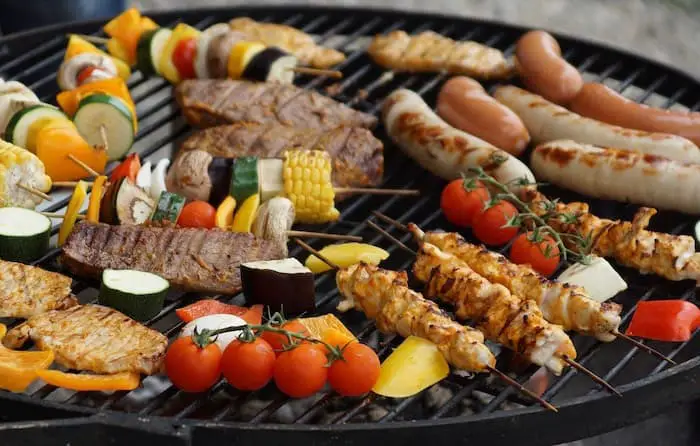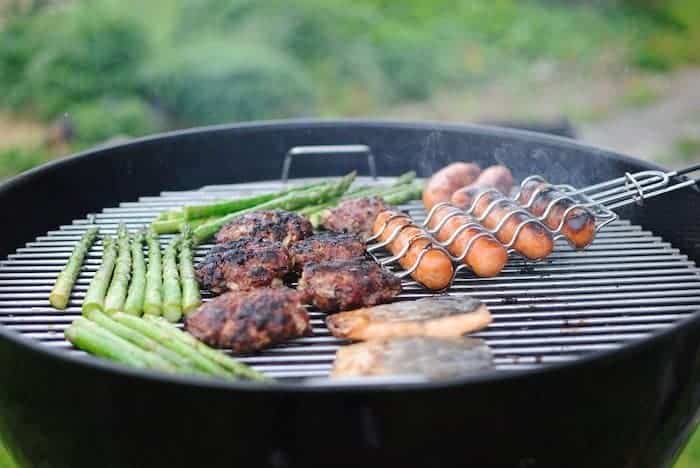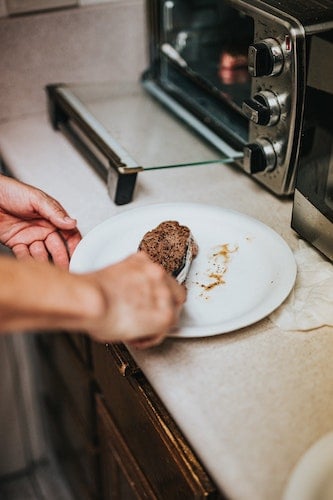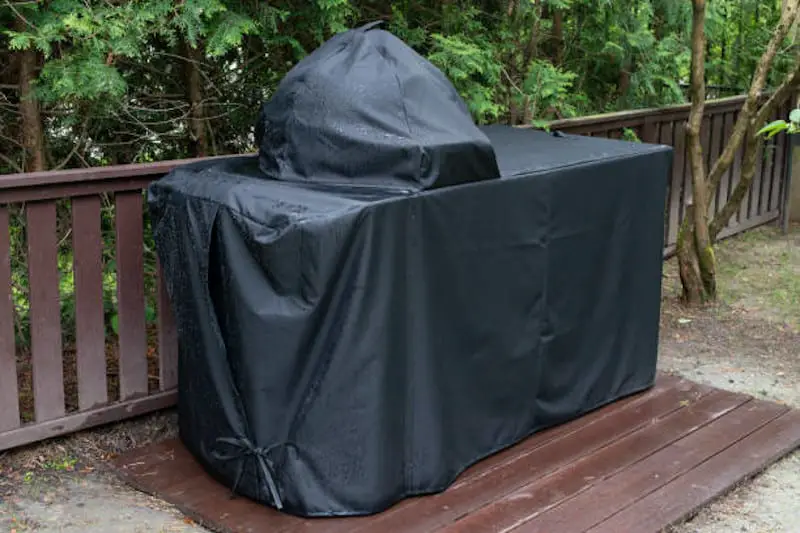
To start off, both techniques of charring food are useful if you wish to enhance the flavors of your dish and retain its juices. Both techniques are similar since they use dry heat to add flavor to your meal. Now, although both methods result in adding a burned, rather crispy crust to your meal, the taste of a blackened steak differs greatly from that of a grilled one.
Is there a difference between blackened and grilled food? The short answer is yes, there is a significant difference in their flavor. The difference is rooted in spicing. The blackening of food is based on using a seasoning mix consisting of herbs and different spices to capture the wild taste of your charred meal. Grilling, on the hand, can be done with any spice of your choice. You can also choose to place your chicken straight on the grate, and voila! You get to enjoy your juicy smoked chicken.
Therefore, while blackening is seasoning-oriented, grilling capitalizes on smoking for that intense flavor. However, if you are a true outdoor chef, it’s best to understand the basics of these two cooking methods and the procedures used. Therefore, if you have been struggling to draw the line between blackening and grilling your food, read on to learn more.
What is the Difference Between Blackening and Grilling?
The difference between blackening and grilling can be summarized by the taste of the two differently cooked foods. The blackening of any food is majorly reliant on an extensive seasoning procedure. This technique uses a range of herbs and spices such as paprika, cayenne, garlic powder, pepper, onion powder, and a blend of herbs.
Grilling, on the other hand, does not rely on seasoning. That’s not to say that you cannot season your food before you grill it, but most of the flavor resulting from grilling tends to come from smoke and your own choice of spice. Whether you season your food or not, the taste of your food is reliant on the quality of smoking, as this method depends on smoking to give you that distinctly grilled taste.
While the difference between grilling and blackening can be broken down to the taste of the food, there is a benefit to understanding them in a more in-depth manner. Therefore, we will look at the basics and technicalities of both methods.
Blackening
Blackening is a cooking method invented in the 1980s by Chef Paul Prudhomme, who sought to replicate the taste of charred meat. Ever since, the procedure and technique of blackening has evolved, leading to the creation of one of the most scrumptious meals in hotel-blackened food. The best foods to blacken are fish, chicken, steak, and any other kind of meat.
When blackening, the meat is first dipped in melted butter, after which it is dredged in blackening seasoning. When it comes to seasoning, you can use your own homemade seasoning mix or a pre-blended one designed specifically for blackening. If you choose to purchase pre-blended seasoning, be on the lookout for Chef Prudhomme’s choice of ingredients – paprika, cayenne, oregano, onion, salt, pepper, and garlic. We cannot emphasize this enough.
So what is the procedure of blackening? We have gone the extra mile and covered the step-to-step guide for blackening your meat.
Method of Blackening my Dishes
Step 1: Heat your cast iron skillet or modern hot pan on a high temperature for about 10 minutes.
Step 2: As the pan is heating, dip your chicken or any other meat into melted butter and mix it well before seasoning with a blackening mixture of Cajun Spices. The ideal size of meat is one quarter to three-quarters of an inch thick.
Step 3: Pat your meat dry to make sure the butter and seasoning mixture stick to the meat.
Step 4: Place the meat in the hot pan or cast-iron skillet. Be prepared for a billowing pillar of smoke that may overwhelm the kitchen chimney.
Step 5: Allow the meat to cook on both sides, each taking about 3 minutes depending on the thicknesses of the meat.
Step 6: Once the meat is cooked, serve.
The result is meat, fish, or chicken with a deep brown or black crunchy crust. The procedure may be challenging to get right at first, but with a little practice and a smokey kitchen, you will soon be a guru at preparing your blackened meals.
Grilling

Grilling, in layman’s terms, is the type of cooking that people tend to do in the backyard on an open fire with cooking grates. Grilling is done directly over a fire, the source of which can be gas, firewood, or even hibachi. Unlike blackening, grilling is suitable for almost all types of food, including steak, pork chops, vegetables, and fruit.
With this method of cooking, the trick is to prepare a meal balanced somewhere between well-cooked and burned. As such, the grill is usually heated to extremely high temperatures of 300-500°F. You can season your meat, but not all types of seasoning is ideal. The following is the method to grilling your food.
Method for Grilling Your Food
Step 1: Pound your meat pieces to reduce the thickness of each chunk of meat. When it is well pounded, cover it in a plastic wrap to ensure the juice of the meat is not lost. For the best results, use a meat tenderizer with flat sides or a rolling pin.
Step 2: Place the pounded meat in a bowl and marinade it, preferably using marinating ingredients with a high oil content. Avoid sweeteners as they tend to make meat stick to the grates when grilling.
Step 3: Place the marinated meat in the refrigerator to allow it to marinade completely. Note that this step is purely optional.
Step 4: Using a pair of tongs, run a paper towel dipped in oil along the grates to oil them completely.
Step 5: Preheat the grill at temperatures of 400F to prepare it for smoking.
Step 6: Get the marinated meat from the refrigerator and wipe off the marinade. If you chose to brine your meat, pat it until it is dry.
Step 7: Spread the pieces of meat on the grill to allow them to start cooking. For even cooking, place the pieces evenly in one layer.
Step 8: When grilling, each side of the meat should take about 4 minutes to cook well. Note that it is dangerous to consume uncooked meat, so you should use a meat thermometer to be sure that the temperature of the meat is 165°F before you finish cooking. If you do not have a thermometer, you can slice the meat to check the inside and make sure it is not pink in color.
Step 9: Once you are sure that all of your meat is well smoked and cooked, serve it hot. Allow the smoked meat to sit on the plate for five minutes. This is important for the meat to retain its juices, which gives the meal its delicious flavor.
Why Does the Meat or Fish Turn Deep Brown to Black?
The appearance of both blackened or grilled meat are typically the same from the outside. Both meals develop a deep brown or black, crusty look on the outside. However, the cause of this change in color and crusty feel is different for both methods.
The blackened look after blackening your meat is caused by the charring of the butter mixture on the hot pan or the cast iron skillet. On the other hand, when grilling, the dark brown or black color is due to the high temperatures of smoking. Grilling is about deliberately burning your food at given temperatures until it caramelizes and builds a complex flavor, so it will naturally have a burned-looking exterior.

The Best Food to Grill
When considering the types of food to grill, look at the amount of food the dish will require for cooking. Does the food require direct or indirect heat? How long will it take to prepare the meal? With these considerations in mind, you can crank up your grill.
Some of the most common dishes that are best prepared by grilling include:
- Beef
- Chicken
- Pork
- Seafood
- Vegetables
- Fruits
Which is the Best Fish to Blacken?
Blackening is a common method for preparing fish. Blackened catfish in particular always makes a good dish. Other types of fish you can consider include redfish, drum catfish and any other snapper fish.
How to prepare your Home-Made Blackening Seasoning Mix?
A good blackening seasoning offers a touch of heat blended with an herbaceous note and spicy taste. For the best blackening seasoning, the mix should revolve around chili, herbs, and spices to capture and release huge flavors with huge blasts of heat.
Now that you know the contents of a good seasoning mix, this is how you can prepare a homemade blackening seasoning:
- Simply put 1 tablespoon each of smoked paprika, cayenne powder, onion powder, garlic powder, ground ball pepper, and sea salt in a mixing bowl.
- Add ½ tablespoon of dried basil, oregano, and dried thyme.
- Mix all of the ingredients until they are well mixed.
- Place your homemade blackening seasoning in an airtight container and store in a cool and dry place. It should last as long as any other spice.
For big and bold spicy flavors, it is recommended that you use smoked paprika and a spicier blend of cayenne powder. If you wish to personalize your blackening seasoning, you can also add more cayenne pepper for that extra heat or dried basil for that sweetness of herbs.
Grilling Recipes to Try Out
Summertime can be fun until you run out of ideas or recipes to grill when hosting your guests. Highlighted below are some of the easiest and best grilling recipes that anyone can handle.
Recipe for Grilled Basil Chicken With Tomatoes
Ingredients needed: 8 plum tomatoes, ½ Teaspoon salt, ¾ cup balsamic vinegar, 2 tablespoon olive oil, ¼ cup fresh basil leaves, 1 minced garlic clove, boneless chicken breast halves.
Procedure
- Place the marinating ingredients in a blender and add chopped tomatoes. Blend the tomatoes.
- Place the chicken in a bowl and add 2/3 cup of marinade. Place it in a refrigerator for about an hour. Turn the bowl regularly.
- Place the chicken on the preheated oiled grill.
- Allow it to cook to 165°F. This should take 4-6 minutes for each side of the chicken. Let it cook until it turns brown.
- When cooked, allow the chicken to settle for about 5 minutes to retain the juices.
- Serve the grilled chicken with the remaining marinade and tomatoes.
Other recipes you can try include:
- Lemon Shrimp and Tomatoes
- Corn on the Cob with Lemon
- Grilled Spinach Feta Burgers
Blackening Recipe to Try Out
Have you been toying with the idea of blackening your food? Check out the following three recipes that you can try out.
Recipe for Blackened Catfish Fatija
This is a recipe to serve 2 – 4 people. The ingredients used are the same as those used for blackening any food.
- Heat a hot pan or cast iron skillet and a tablespoon of sunflower oil.
- For the Fajitas, when the oil is hot, add onions, bell peppers, salt, and black pepper and leave it for 5- 8 minutes. Remove the vegetables and set them aside.
- Place the pieces of catfish in melted butter and ensure they are completely covered in the butter.
- Place the buttered fish pieces in the cast iron skillet. You can add more oil if necessary.
- Cook the fish for about 3 minutes, then add the veggies into the same pot as the catfish.
- Toss to combine thoroughly.
- Add seasoning to your preferred taste.
- Serve the catfish Fajitas with warm cotija cheese, sour cream, tortillas, and lime.
- Enjoy your meal.
Other recipes that you can try out are:
- Blackened Chicken Alfredo
- Blackened Salmon with Mango Salsa
- Blackened Shrimp Tacos
Effects of Eating Blackened or Grilled Food on Health

Over the years, there have been heated debates about the health risks associated with eating grilled or blackened food. Extensive research proves that excessive consumption of these foods increases the risks of developing cancer.
The longer you cook meat, the more dangerous it is for consumption, due to the forming of heterocyclic amines (HCAs). These HCAs are formed when extreme heat causes a chemical reaction with naturally occurring amino acids found in proteins. These HCAs are among a number of amino acids known to increase the risks of developing cancer of the colon, pancreas, and digestive tract.
While grilling, fats may drip on the coal or grate, causing flare-ups. These flare-ups, in turn, cause polycyclic aromatic hydrocarbons (PAHs), which are carried by the smoke that coats our food and gives it that rugged taste. This means that we directly consume these PAHs, which are further associated with an increased risk of developing stomach cancer.
Therefore, blackened or grilled foods in general are typically a source of carcinogenic chemical which, when consumed, can directly affect our DNA, potentially initiating mutations that can lead to the development of cancer.
So, does this mean you should avoid these deliciously cooked foods? The good news is, you can still enjoy your blackened food and remain healthy. All you have to do is be careful of the amount of grilled or blackened food you consume, and the regularity with which you consume it.
Related Questions
What is the difference between Blackened Seasoning, Creole Seasoning, and Cajun Seasoning?
All of these blends of seasoning share common ingredients that puts them under the same category. However, the difference lies in their intensity. The mixture with the most intense spice is Cajun seasoning, while Creole seasoning is more herb-based. Blackening seasoning is considered the middle ground between the two. Therefore, if you are not sure which way to go, blackening seasoning may help you identify which intensity of seasoning you want for the next cookout.
What is the Difference between Barbequed and Grilled food?
The difference between these two foods lies in the cooking technique. For one, while grilling is done over direct high heat, barbequed food is prepared under low, slow, and indirect heat. For the best barbequed meals, cooking takes a longer time, which means extra burning when grilling. Grilling, on the other hand, takes a maximum of 10 minutes.
Can I Use barbeque Sauce for Grilling?
Despite the name of the sauce, it is possible to use the barbeque sauce for marinating your streak right before you toss it on the grate. So yes, go ahead and use the sauce to your liking.
See Also:
Can I Convert Natural Gas Grill To Propane
5 Best Non Stick Spray For Grill
Difference between Broil and Grill




Leave a Reply